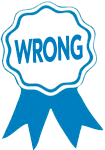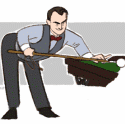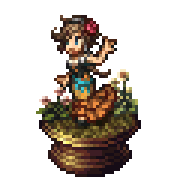|
Gomi posted:Well, it's people doing random disgusting things and pretending it's deep, which is pretty much in line with the last 3 decades of performance art, so 'dumb' maybe but I guess not grognardy. Pretty much. I mean, it's artsy-dumb if anything.
|
|
|
|

|
| # ? Apr 25, 2024 18:51 |
|
It's only grognardy in the loosest sense (like tons of stuff in this thread), but my take on being groped in a strobing greenlit room by a bunch of flour-covered LARP dudes in their underwear while we all pretend to be dying is that it is nowhere near "pretty awesome."
That Rough Beast fucked around with this message at 03:29 on Jun 8, 2010 |
|
|
|
This Troper has a rep as a Killer Game Master, and is trying to shed it- but it's not entirely undeserved, as I do enjoy adding a large hskew to my games. I have, however, put the fear of God (that is, me) into my players. If I gave them a perfectly normal, untrapped treasure chest- in a level 5 adventure- in the middle of an empty room at the end of a dungeon, they would not dive right in. Oh no. The minmaxer rogue will search it for traps, then search the pedestal for traps, then search the room for unexpected traps, and then and only then would they attempt to unlock and open it using ten-foot poles. I don't often throw them Monty Hauls, either- and when I do, they have to *earn* them. There was one campaign arc during which I sent them to a dead world (also a Death World), wherein the sun had died and the Plane of Shadow had merged with the Prime Material. Volcanism still super-heated the polluted water, however, and as a result there were *continent-sized boiling acid hurricanes* ravaging the landscape. Everything still surviving was incredibly hostile, the planet was knee-deep in undead, and to top it all off? At the end of the trail was a dungeon that is to this day referred to only as "The Temple of Burned Character Sheets." Think the Tomb Of Horrors, taken Beyond The Impossible. If you can imagine the boulder from Indiana Jones as a giant sphere of annihilation instead, you might begin to get the picture- and it only got worse from there.
|
|
|
|
Sad Mammal posted:This Troper has a rep as a Killer Game Master, and is trying to shed it- but it's not entirely undeserved, as I do enjoy adding a large hskew to my games. I have, however, put the fear of God (that is, me) into my players. If I gave them a perfectly normal, untrapped treasure chest- in a level 5 adventure- in the middle of an empty room at the end of a dungeon, they would not dive right in. Oh no. The minmaxer rogue will search it for traps, then search the pedestal for traps, then search the room for unexpected traps, and then and only then would they attempt to unlock and open it using ten-foot poles. I don't often throw them Monty Hauls, either- and when I do, they have to *earn* them. There was one campaign arc during which I sent them to a dead world (also a Death World), wherein the sun had died and the Plane of Shadow had merged with the Prime Material. Volcanism still super-heated the polluted water, however, and as a result there were *continent-sized boiling acid hurricanes* ravaging the landscape. Everything still surviving was incredibly hostile, the planet was knee-deep in undead, and to top it all off? At the end of the trail was a dungeon that is to this day referred to only as "The Temple of Burned Character Sheets." Think the Tomb Of Horrors, taken Beyond The Impossible. If you can imagine the boulder from Indiana Jones as a giant sphere of annihilation instead, you might begin to get the picture- and it only got worse from there. "N-no, dad, gently caress YOU...."
|
|
|
|
Sad Mammal posted:I honestly cannot make myself understand dms like this. maybe I'm just a big bleeding heart or some poo poo but I can't imagine taking joy in rubbing my hands and saying, "hee hee hee, looks like your fourth character just bit the dust" without feeling a spark of self-awareness and suddenly realizing that I was a miserable imitation of a social being. even in an adversarial game like paranoia I can't figure out the draw of just going for maximum pc deaths. how can you even be that poo poo. how is it possible
|
|
|
|
Everything else aside, I'm intrigued by his hell-world setting. It's just so ridiculous, I need to know more.
|
|
|
|
Angry Diplomat posted:even in an adversarial game like paranoia I can't figure out the draw of just going for maximum pc deaths. how can you even be that poo poo. how is it possible Dungeons like the one mentioned above are fun if the players know that it's the ultimate ridiculous death challenge and they're not sending their precious played-for-two-years-of-real-time PCs there. The Tomb of Horrors is vicious because it was a tournament module, after all.
|
|
|
|
Angry Diplomat posted:I honestly cannot make myself understand dms like this. maybe I'm just a big bleeding heart or some poo poo but I can't imagine taking joy in rubbing my hands and saying, "hee hee hee, looks like your fourth character just bit the dust" without feeling a spark of self-awareness and suddenly realizing that I was a miserable imitation of a social being. Especially since the GM can literally just declare characters dead, or arbitrarily raise damage until they die, etc. It's not even like it's a matter of gloating over skill, or about having won the game or beaten someone else.
|
|
|
|
Halloween Jack posted:Well, there are the games where the players are going for maximum character deaths. I remember reading an anecdote from a guy in a Paranoia LARP, who got himself killed by some kind of giant moving static charge thing that killed people while also sticking them to itself. Because he set it off, it literally snowballed through the playing area, becoming a gigantic Katamari of dead bodies. As long as everyone's in on it, that kind of thing is a blast. See, though, that has a basis in fun though, like, he died to do something funny as hell. I just can't grasp that there are people who honestly enjoy killing fake people for no good reason. Christ at least with GTA and all you get a neat fake blood spurt and ragdoll physics, with D&D it's just 'welp, sure am dead'.
|
|
|
|
shotgunbadger posted:See, though, that has a basis in fun though, like, he died to do something funny as hell. I just can't grasp that there are people who honestly enjoy killing fake people for no good reason. Christ at least with GTA and all you get a neat fake blood spurt and ragdoll physics, with D&D it's just 'welp, sure am dead'. Is this why you can't see the joy in killing a fake dragon with your fake elf using your fake sword enchanted with fake magic (god isn't real)?
|
|
|
|
double postin' like a champ Y'know how Grognards are proud that the DM can spend 20 hours a week on making your Gygaxian Naturalist game work entirely within the rules? Well, some one just proved it to win a flame war. Its a wall of text, so I've got some notes interspersed. quote:Spells and spellcasters in a campaign world
|
|
|
|
Roleplaying is less fun because I have seen that.
|
|
|
|
has anyone on EARTH read that entire post?
|
|
|
|
CaptainJuan posted:has anyone on EARTH read that entire post? Having skimmed it for the clumps of best grog, the Executive Summary: I really hate that people refuse to properly simulate the world in which dragons fly and magic works. So I'm going to use the tables in the DMG to figure out how many spell casters there are on the planet (assuming the entire planet = Tolkien Middle Earth) and then make a huge amount of Drake Equation level assumptions in order to show how many unique spells are being created per year. This is important because, P.S. I already know that Elves rule, here is why:
|
|
|
|
Gerund posted:P.S. I already know that Elves rule, here is why:
|
|
|
|
Just want to put out Land of OG as one the good games for converting 'non-gamers' out there. The game is basically charades with a narrative and a thin speck of game mechanic. Oh, and possibly the most hilarious thing you can do with friends.
|
|
|
|
Dominion posted:Especially since the GM can literally just declare characters dead, or arbitrarily raise damage until they die, etc. It's not even like it's a matter of gloating over skill, or about having won the game or beaten someone else. It's not just randomly killing PCs though. It's killing dumb PCs Hell, I personally love putting poo poo in that the PCs can't beat and are forced to retreat and rethink the situation. It's a trademark of mine, and something I warn at the start of every campaign I run. Fighting isn't the only answer and at times is a very good way of getting killed. To me, RoleMaster is a fantastic game as it makes PCs second think running into a room with swords a swingin' because it's pretty likely they might lose a limb in the process. Slows them down, makes them reconsider and think in a more realistic approach to even the most tame of fights. One of my fondest memories of the system was a very minor bar brawl, where a halfling shattered my knee with a lucky punch.
|
|
|
|
quote:While the method of determining these levels is explained in the DMG, the results generated here require some explanation. All of the average dice results result in a number that ends with a .5 aspect to it. This slightly skews the data, because it means half the time the number will be 1 greater than it will be the other half of the time, and this does affect the numbers generated for this community. As such, what I’ve done here is take two classes that roll similar dice, and assign the higher part of the average to one class, while the other gets the lower average. [...] quote:(Just for fun (Oh Lord), let’s see what other assumptions we can make about this hamlet based on the data we’ve generated. For example, the 2nd-level cleric is probably the local spiritual counselor, who together with the two 1st-level clerics who most likely serve as his aides, maintains a small church. It’s not too much of a stretch to suggest that this religion has a monastic order as well, which would make the 1st-level monk part of the church order as well. This forms the pillar of the religious part of quote:More specifically, (again using medieval Europe as a rough guideline) we’ll assume a world population of about 70,000,000 people quote:So, when only 3.8% of the world’s 70,000,000 people is a spellcaster, that gives us a general spellcasting populace of 2,660,000. quote:Now, in order to gauge the number of distinct spells in existence, and being created over time, let’s make some assumptions. quote:Now, a lot of assumptions were made in generating these figures. Canny readers will have picked up on a common theme for all of these assumptions (in fact, it was even mentioned a few times): they’re all relatively conservative in the numbers they estimate. Everything he calculated is absolutely worthless. I hope it was pointed out to him and he killed himself out of shame and despair over the wasted effort.
|
|
|
|
fighting grognard with grognard I see
|
|
|
|
Ashenai posted:fighting grognard with grognard I see
|
|
|
|
Turing sex machine posted:Yes but see I am the smart grognard The only good grognard is a dead grognard.
|
|
|
|
Turing Sex Machine is correct, but at what cost? He is like a necromancer who uses his magic to fight other, more evil, necromancers.
|
|
|
|
joke's on you then because necromancers are awesome and if they weren't so evil all the time pretty much everybody would want to be friends with them. "hey can you bring my dead husband back as a ghost" "hey can you help me turn into a lich" "hey can I hire some zombies off you to mow my lawn"
|
|
|
|
^^^^^^^^^^^^^^ Actually it's totally true. In a world where people were a little more lenient about the treatment of the dead, D&D-style Necromancers would have an INCREDIBLY useful skill. Zombie and skeleton labour would be extremely important, for a start. EDIT: It's me, etc.
|
|
|
|
Epicurus posted:EDIT: It's me, etc. Not really, it's been done before. See the dustmen in Planescape.
|
|
|
|
More worst experience in the making than grognard: I play D&D all the time.In D&D,I prefer to play as a Drow.Drows fit my personality more....i don't know why. Sincerely, Emily, The D&D fanatic.
|
|
|
|
Epicurus posted:Actually it's totally true. In a world where people were a little more lenient about the treatment of the dead, D&D-style Necromancers would have an INCREDIBLY useful skill. Zombie and skeleton labour would be extremely important, for a start. that's just the beginning though. you'd get powerful or wealthy people being all "my body can't take anymore resurrections so please just bring me back as a sentient undead okay" which in turn would lead to necromancer retainers who can mend their undead forms and protect them from turning. you'd have like a whole guild of dudes who just talk to the dead, and it would be a totally normal event for a guy to wander down to the local guild hall to ask his dead mother for advice about his family business necromancy would probably be seen as a slightly unpleasant but definitely very important job, like being a coroner, surgeon, and palliative care worker all rolled into one. if some religious zealot started a "kill all necromancers" movement the general reaction would be "are you loving insane" hmm, I think I just inadvertently built part of a new setting for my next campaign
|
|
|
|
Angry Diplomat posted:that's just the beginning though. you'd get powerful or wealthy people being all "my body can't take anymore resurrections so please just bring me back as a sentient undead okay" which in turn would lead to necromancer retainers who can mend their undead forms and protect them from turning. you'd have like a whole guild of dudes who just talk to the dead, and it would be a totally normal event for a guy to wander down to the local guild hall to ask his dead mother for advice about his family business I once played a cleric of Pelor who had just arrived Clueless in Sigil, and the party she was teaming up with was going to the Mortuary to retrieve a faction prisoner, and she was basically super into it because she was like "there is like an entire castle full of people abusing the dead right here inside city limits, there is no question but every single one of these people must repent or die" It was interesting juxtaposing Planescape's belief morality with vanilla D&D's taken-for-granted extremism in pretty much exactly that sort of way
|
|
|
|
That giant essay about casters owns. I don't care if it is wrong, somebody wrote all those words about elfgame, and that's hilarious.
|
|
|
|
Turing sex machine posted:
He did get a chuckle out of me when I saw him get to "Based on my assumptions, there would be 2500+ new spells invented every year", realized there was no way anyone wouldn't laugh at that, and started chopping away at it. But my favorite is the unstated assumption that divine casters do exactly as much spell research as arcane casters. "Hey Bob, I just made up a brand new prayer for -- " *gets stoned to death"
|
|
|
|
projecthalaxy posted:That giant essay about casters owns. I don't care if it is wrong, somebody wrote all those words about elfgame, and that's hilarious.
|
|
|
|
Did anyone get flashbacks to the FATAL guy with that huge rear end essay about casters? Based on my bullshit presuppositions I can show how my point is completely correct!
|
|
|
|
SweeneyTodd posted:He did get a chuckle out of me when I saw him get to "Based on my assumptions, there would be 2500+ new spells invented every year", realized there was no way anyone wouldn't laugh at that, and started chopping away at it. quote:But my favorite is the unstated assumption that divine casters do exactly as much spell research as arcane casters. well, druids do spell research. favored souls probably do too.
|
|
|
|
I would think in a primitive world with no rapid communication and no printing press, between members of a trade that are rare, known for preferring solitude, and prone to being eaten by summoned demons, the vast majority of these researched spells would be endless rewrites and slight variations on existing spells, rather than millions and millions of completely original, unique spells. Plus, there's the incredible cost of spellbooks (If nothing else), so a publicly accessable library of, say, one thousand second level spells would be worth millions of gold. There's no way it wouldn't be rapidly destroyed by thieves, marauding armies, power-hungry necromancers, and rear end in a top hat adventurers. And yet somehow there's supposed to be a huge accumulation of magical knowledge?
|
|
|
|
|
Mystic Mongol posted:I would think in a primitive world with no rapid communication and no printing press, between members of a trade that are rare, known for preferring solitude, and prone to being eaten by summoned demons, the vast majority of these researched spells would be endless rewrites and slight variations on existing spells, rather than millions and millions of completely original, unique spells. A wizard did it.
|
|
|
|
happyelf posted:i've written way more words than that about elfgame cool
|
|
|
|
Mystic Mongol posted:I would think in a primitive world with no rapid communication and no printing press, between members of a trade that are rare, known for preferring solitude, and prone to being eaten by summoned demons, the vast majority of these researched spells would be endless rewrites and slight variations on existing spells, rather than millions and millions of completely original, unique spells. he's not saying there's a huge centralized accumulation of magical knowledge. just that there are a bunch of different spells floating around "out there" - this wizard knows 5 or 6, this one knows 3 or 4 different ones, this one knows 8 but 7 are repeats, and so on. With half a million wizards in the world at the low end, that's a whole lot of spells!
|
|
|
|
Riidi WW posted:well, druids do spell research. favored souls probably do too. Real-world clerics do a lot of philosophical research, too. That and the habit gods have of moving in mysterious ways probably leads to some development of new, 'functional' prayers.
|
|
|
|
Mystic Mongol posted:I would think in a primitive world with no rapid communication and no printing press, between members of a trade that are rare, known for preferring solitude, and prone to being eaten by summoned demons, the vast majority of these researched spells would be endless rewrites and slight variations on existing spells, rather than millions and millions of completely original, unique spells. I think that was one of his points. I'm sure I remember reading something like "only 1 in 20 wizards ever invent a new spell in the course of their entire life" or something like that but gently caress if I'm going to go back and parse that lump of textual vomit again.
|
|
|
|

|
| # ? Apr 25, 2024 18:51 |
|
quote:- fully 50% of all new spells that are invented are never passed into any sort of record, dying with their creator. Whether due to negligent records, something happening before they could distribute copies, or simply not having a means or desire of passing their knowledge on, half of all new spells created each year are lost to the world.
|
|
|































